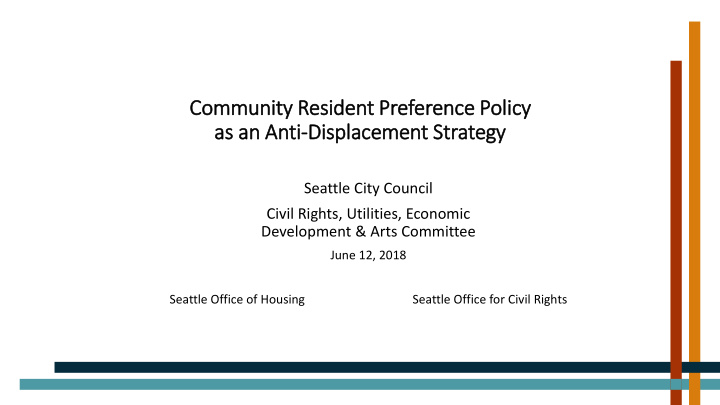



Co Community Resident Preference Poli licy as an Anti-Displacement Str trategy Seattle City Council Civil Rights, Utilities, Economic Development & Arts Committee June 12, 2018 Seattle Office of Housing Seattle Office for Civil Rights
TOPICS 1. Introduction 2. Seattle’s History of Racial Discrimination Discriminatory policies and impact Fair housing history Housing strategies to affirmatively further fair housing 3. Affirmative Marketing 4. Community Resident Preference National examples and initial take-aways 5. Next Steps Demographic and displacement data; legal research Community engagement and input National policy dialogue
1. Introduction Tailor affordable rental and ownership housing leasing/sales to further specific policy goals Policy Goals: • Provide affordable housing opportunities for local communities • Anti-Displacement: Support at-risk communities and/or assist affected individuals • Address history of racial discrimination and advance racial equity Community Resident Preference – Common approaches: • A portion of rental or ownership units in affordable development are set-aside • Preferred applicants may be local residents, workers, former residents, people who have been displaced • Lottery used to select affordable housing residents / buyers • Policy must affirmatively further fair housing – explicit analysis of racial impact
2. History of Seattle: Structural Racism and Discrimination • 1800s – Colonization of Native American land • 1870-1920s – Segregation of Asian Immigrants • 1920s – Racial Covenants exclude people of color • 1930s – Redlining blocks investment and wealth building • 1940s – Internment of Japanese Americans • 1960-1980 – White flight; Black and Brown concentration in cities
Seattle Racial Covenants and Redlining Eastlake Deed: Said lot or lots shall not be sold, conveyed, or rented nor leased, in whole or in part, to any person not of the White race ; nor shall any person not of the White race be permitted to occupy any portion of said lot or lots or of any building thereon, except a domestic servant actually employed by a White occupant of such building.
Impact of Racial Covenants and Redlining Home Owners’ Loan Corporation Current Racial Grade of Desirability Segregation: 1936 % People of Color A. Best (green) 15% B. Still Desirable (blue) 22% C. Definitely Declining 42% (yellow) D. Hazardous (red) 52%
Fair Housing History • Role of the Civil Rights Movement and community organizing • Fair Housing Act of 1964 • Seattle’s Open Housing Ordinance – addressing discrimination • 2015 HUD Rule – Affirmatively Furthering Fair Housing • Disparate Impact – addressing barriers to housing • Anti-Displacement
Housing Strategies to Affirmatively Further Fair Housing • Significantly increase supply of affordable rental and ownership housing • Location priorities to achieve balanced, citywide investments • Communities with a high risk of displacement • Communities with high access to opportunity • Population priorities, serving range of populations
3. Affirmative Marketing Goal: Provide equal access to housing choices regardless of race, national origin, familial status, disability, other protected class status Applies to: • City-funded housing: 6 buildings/600 units opening per year* • City incentive programs: 30 buildings/600 units opening per year* Examples: In addition to marketing to the general public: • Early outreach to neighborhood and cultural community groups • Advertisements in neighborhood and community publications • Translated materials and language assistance Impact: People unlikely to apply are aware of housing opportunity and are able to apply *Based on recent trends for Rental Housing and MFTE programs
4. Community Resident Preference Goal: Address historic and current displacement by providing preference for community residents during leasing or sales Examples: New York City, San Francisco, Portland • % of units set-aside for people who live near the housing development (or work nearby, or previously lived nearby) • Lottery to select residents (or “tie - breaker” for ownership housing) • Variety of approaches Intended Impact: Housing residents include current community residents at risk of displacement and reflect the demographic mix of the area
Example: New York City Community Preference Policy • Since 1980s • All funded projects, citywide • 50% of units at lease-up • Preference: neighborhood residents
Example: San Francisco • Since 2016 • 40% of units, at lease up or initial sale Neighborhood Preference Policy • All funded projects except HUD-funded • Preference: residents of district, or within ½ mile Anti-Displacement Preference Policy • Projects receiving City and HUD funding • Preference: residents of six high displacement risk neighborhoods
Example: Portland, OR Affordable Housing Preference Policy, N/NE Neighborhood • Since 2015 • Funded projects in Urban Renewal areas of N/NE Portland • 40% of units, initial lease up or sale • Preferences: • First priority: residents with property taken by eminent domain, their descendants • Current or former residents
Initial Take-aways Policy must affirmative further fair housing, not perpetuate segregation • Demographic data on geographic areas • Data demonstrating displacement Policy must not disadvantage members of a protected class • Community preference area has diverse population • Multiple preference points Policy must recognize other fund source requirements • Affirmative marketing and resident preference • Admissions policies such as wait lists
5. Next Steps • Community Input -- fit with community’s racial equity and anti-displacement efforts • Demographic and Displacement Data • Legal Research; Federal Regulatory Actions • National Dialogue • Policy Recommendation
Recommend
More recommend